Shep Hyken's Blog, page 70
January 28, 2022
Guest Post: How Does Software Enhance the CRM of Your Business?
This week we feature an article by Joy Gomez, founder of Field Promax, a company that helps organizations streamline and standardize their workflow, manage teams, communicate with customers, process work orders digitally, and grow their business. He shares the 5 ways a CRM can influence the customer and business part of your organization.
Customers play a crucial role in establishing the position of a business in the market. When looking at customers, there are various aspects to consider, such as customer services, customer value, customer feedback, customer communication, etc. Managing customers reflect on the revenue and the evaluation of the brand for any business.
Manually keeping track of all your business is visibly impossible. However, with the help of technology and the invention of software, it is possible to manage different customer relationships all in one place.
What is CRM?CRM is the abbreviation for customer relationship management. It refers to all connections between the business and the customer using various tools. The CRM system covers sales, business development, marketing, recruiting, etc., the required resource to manage communications with clients and other stakeholders. The tool gives you access to customer information, prospects, provide details on sales opportunities, marketing campaign data, service issue history, customer interaction details, and more all in one place.
Why do you need CRM?Finding customers, maintaining a proper relationship, and providing them with what they require can be challenging. CRM gives companies complete information and details on their clients’ and customers’ processes. The comprehensive tool helps you manage and monitor all your sales, marketing, service, revenue, etc., from all platforms in one place. You also get easier access to customer databases and all kinds of information about them. They are used as marketing tools that help with decision-making and benefit the company in every way possible. The CRM tool helps you stay updated with your lead flow and figure out how and whom to prioritize and respond effectively. It keeps your sales and marketing team in check and helps them manage customers efficiently.
Here are five ways in which CRM has enhanced your business’s workings. Customer supportWith queries and issues, the level of patience has fallen short. However, technology has substituted the waiting hours with AI-based solutions to provide instant support. The CRM system helps provide high-quality service and quick access to customer orders, records, and information for effective communication and efficient support. Customer service can add to the business’ advantage in maintaining standard customer relationships with immediate support and information
Customer relationshipBesides providing constant support, maintaining a proper relationship with the customers turns them into leads. With the increase in the customer database, centralized and streamlined communications can become difficult. CRM can provide easy access to customer data and critical information, impacting customer retention by maintaining quality customer relationships.
Customer and leadsThe CRM system helps you recognize leads, categorize them and differentiate them from the other customers. Companies can focus on the right leads and generate sales with high returns with detailed dashboard views and charts. It helps prime customers to become prime leads and focus energy on the right clients, proper sales, and marketing with accurate information.
EncryptionThe CRM system also ensures the security and privacy of customer information. Along with storing all the data, it also scrutinizes who can view the details and how much. All CRM systems follow GDPR General Data Protection Regulation which lets you obtain documents with the contact’s permission to store or use them. It builds the trust and confidence of the customers towards the company
ProductsAlthough CRM focuses on enhancing customer relationships, it also influences the functioning and production of the business itself. Based on CRM data, organizations can understand their customers better, improve their service, customize their offers, spot issues, receive feedback, and more. It helps companies fix their problems at early stages, alter and improve their business efficiently with customer feedback and analysis.
CRM done manually can be very time-consuming and hectic, so there is software for the same. Various software helps with CRM, like Field Promax, Salesforce, Zoho, Hubspot, Monday.com, etc. Field Promax is a field service software that helps business owners connect with their customers efficiently. It is synced with QuickBooks integration to access a wide range of customer data. The software has a 24/7 customer support portal and is very user-friendly. It helps industries manage their customers with accurate details and provide a platform for proper communication.
These are 5 ways CRM can influence the customer and business part of your organization. It helps provide better service and receives better customer support and leads. CRM system is designed to enhance the customer-oriented parts of your business and enrich your production through all means possible.
Joy Gomez is the founder of Field Promax. He is a self-taught, process-driven programmer and a first-generation immigrant from Southern India.
 For more articles from Shep Hyken and his guest contributors go to customerserviceblog.com.
For more articles from Shep Hyken and his guest contributors go to customerserviceblog.com.
Read Shep’s latest Forbes article: Happy Customers Mean Happy Employees
The post Guest Post: How Does Software Enhance the CRM of Your Business? appeared first on Shep Hyken.
January 26, 2022
Stop Sending Me Surveys Unless You Care What I Have to Say!
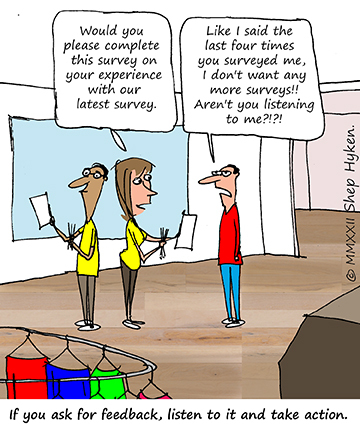 I’m getting survey fatigue. But it’s different than it used to be. In the past, companies have sent me surveys that were so long I became tired – or fatigued – at some point during the survey, and as a result, I wouldn’t complete it and therefore the company never received my feedback. We’ve covered survey length before, and that’s not what this is about. This time I’m talking about being fatigued, as in sick and tired of getting so many surveys.
I’m getting survey fatigue. But it’s different than it used to be. In the past, companies have sent me surveys that were so long I became tired – or fatigued – at some point during the survey, and as a result, I wouldn’t complete it and therefore the company never received my feedback. We’ve covered survey length before, and that’s not what this is about. This time I’m talking about being fatigued, as in sick and tired of getting so many surveys.
It seems that almost every time I get my car worked on, call my internet provider, stay at a hotel, fly on an airline, order almost anything online, etc., etc., I get a survey. You get the idea. Hardly a day goes by that I don’t receive one or more surveys in my email inbox from the places I do business with. I’m tired of getting surveys. And do you know why? It’s not even that they are long or that I receive so many. If I have something to say, I’m happy to share some feedback. It’s because I believe that most of my comments are never read. Why do I believe that? Because many times I leave my name and phone number in the comment section for the company or brand to call me. And this probably won’t surprise you … they never do!
That brings me to a recent email I received from the CEO of Walgreens. Of course, the CEO of this great company wasn’t reaching out directly to me. He was emailing everyone who is a member of the MyWalgreens rewards program. His message was short and to the point. The short, paraphrased version of the email was simple: “You spoke, and we listened. This is what we heard you say you wanted, and here’s what we are doing.” The email went on to share some of the changes they were making in their stores.
I liked reading that email. It made me feel like my feedback might have made a difference. When’s the last time you or your company emailed or called a customer to thank them for their feedback and tell them the changes that were being made as a result of their suggestions?
Not every company ignores feedback, but sometimes it feels that way. Feedback is nothing if you don’t do anything with it. Once you collect information from your customers, you must act on it. You must analyze it, use it, make changes with it, and once you have done that, you should communicate with your customers that because of them, change is happening. You must let your customers know you are listening to them!
Shep Hyken is a customer service expert, keynote speaker, and New York Times, bestselling business author. For information on The Customer Focus customer service training programs, go to www.thecustomerfocus.com. Follow on Twitter: @Hyken
customer service training programs, go to www.thecustomerfocus.com. Follow on Twitter: @Hyken
(Copyright © MMXXI, Shep Hyken)
The post Stop Sending Me Surveys Unless You Care What I Have to Say! appeared first on Shep Hyken.
January 25, 2022
Amazing Business Radio: Dave Carruthers
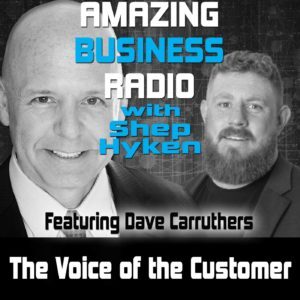 The Voice of the Customer
The Voice of the CustomerUsing Feedback to Drive Change in the Customer Experience
Shep Hyken interviews Dave Carruthers, CEO at Voxpopme, a company that redefines the possibilities of video for market research and customer feedback. They discuss how CX practitioners can move away from just measuring customer feedback to driving real change in the customer’s experience.






 Top Takeaways:
Top Takeaways:VoC or Voice of the Customer is hearing directly from customers about all aspects of their journey to make continuous improvements to all areas of that experience. If done right, it can be a huge driving force for all businesses. So how can companies gather these valuable insights from their customers?
Here are the top 3 ways:
Timely: Real-time feedback is key. The longer the time lapses between the experiencing and asking for feedback, the more likely the customer’s recollection of their journey will be blurred.Flexible: It’s all about giving the choice back to the customers. They should be able to decide when and how they can give feedback.Personalized: CX practitioners should take a look at what they already know about their customers and their experiences and base their subsequent survey/feedback questions on that.Tune in for more insights on collecting, analyzing, and using feedback to make meaningful changes in the customer’s experience.
Quotes:“All customers want to feel heard, that their opinion matters, and that they are not providing feedback which just goes into a black hole.”
“The best companies in the world are meeting customers where they are and allowing them to provide feedback in a medium that matters most to them.”
“Video solicits a richer response from customers. Compared to a text box on a survey where most people would only put in 3 or 4 words, with video, most customers will give 45 to 90 seconds of feedback.”
About:Dave Carruthers is an entrepreneur who specializes in high-growth tech businesses and a video insight evangelist with global ambitions for growth and adventure. He is the CEO at Voxpopme, a company that provides an end-to-end software solution for video research, enabling researchers to capture video feedback at speed, analyze it at scale, and share it with ease.
Shep Hyken is a customer service and experience expert, New York Times bestselling author, award-winning keynote speaker, and your host of Amazing Business Radio.
This episode of Amazing Business Radio with Shep Hyken answers the following questions … and more:
What does VoC or Voice of the Customer mean?When is the right time to send a survey?Does collecting feedback breach customer privacy?What is the biggest challenge for CX practitioners right now? Why are companies struggling with understanding their customers?The post Amazing Business Radio: Dave Carruthers appeared first on Shep Hyken.
January 24, 2022
5 Top Customer Service Articles of the Week 1-24-2022
Each week I read many customer service and customer experience articles from various resources. Here are my top five picks from last week. I have added my comment about each article and would like to hear what you think too.
5 Ways to Ensure Customer Satisfaction in a Supply Chain Crisis by Staples Worklife Magazine(Staples Worklife Magazine) The supply chain crisis is causing product backorders and shipping delays that will affect all shoppers this holiday season. Learn how to ensure customer satisfaction despite supply chain disruptions.
My Comment: I just came across this article and the accompanying infographic this week, and while it may have come out sooner, the timeliness of it couldn’t be more appropriate. In short, this is Staples sharing their take on how to communicate to customers about supply chain issues, which are plaguing many companies and causing customers to become very upset. This may be exactly what you need to save that angry customer.
How Can We Make Our Organizations Truly Customer-centric? by Michelle MacCarthy(diginomica) Customer Success isn’t just the name of a department – it’s a top-down, company-wide philosophy and responsibility to deliver an exceptional customer experience. But that’s easier said than done. Michelle MacCarthy of Unit4 shares practical steps to fulfil the customer-centric promise.
My Comment: The summary of this article says it all. If you’ve studied my work, you know one of my favorite sayings is, “Customer service is not a department. It’s a philosophy to be embraced by every employee, from the CEO to the most recently hired.” That’s exactly how this article starts. To put it in the author’s words, “It’s a top-down, company-wide philosophy and responsibility…” There are several good ideas for you to consider if you want to be “truly customer-centric.”
Why Retailers’ Data Privacy Policies are the New Customer Experience by Jesse Redniss(Retail TouchPoints) Brands have always focused on personal touches and customization for consumers, yet a recent eMarketer report found growing concerns around data privacy, with nearly nine out of 10 consumers saying it’s important to them. In fact, three out of 10 consumers worldwide have switched providers due to concerns with those companies’ data policies or data-sharing practices adding fuel to the fire.
My Comment: Data privacy may not be the most exciting subject to discuss, but there is something that might get you excited. A company’s data privacy policy is part of the customer experience. You want a customer to feel comfortable and confident about doing business with you. Well, read this article to understand how to get started using data privacy to drive a better CX.
How to Build Personalized Experiences Your Customers Will Actually Love by Simonetta Turek(CustomerThink) We are in a new digital experience frontier. In the past two years, digital customer engagement went from being a fun perk to a business critical must-have. As consumers we enjoy the benefits of early access to the sales on our favorite goods, playlists that anticipate our music interests, celebrations when we reach our 100th ride, and much more on a daily, if not hourly, basis.
My Comment: Personalization can give you a competitive advantage. It can cause customers to come back. It can even create loyalty. The author includes four strategies. I like them all, but what caused me to want to include the article in this week’s roundup was number four, as it emphasizes the power of first-party data. If you read number three in today’s weekly roundup, you’ll understand how this all fits into creating a better CX.
3 Trends Driving Brand-Defining Customer Service in 2022 by Sarika Khanna(Total Retail) A year when shifting consumer behaviors and heightened expectations made the jobs of customer service (CS) teams a whole lot more difficult, 2021 illuminated the rising value of great CS for brands looking to pave a path towards success post-pandemic.
My Comment: I want you to pay attention to the three ideas in this article. And if you’re not in retail, it still 100% applies. 1. Know that your customers are more impatient than ever and there is a “need for speed.” 2. What people are saying about you, your brand, and your experience, is more important than ever. Customers talk and your other customers – and potential customers – are listening. 3. There is magic in how you recover when a customer has a problem or complaint. Done right, the customer will appreciate you more than if the problem never happened in the first place.
[image error]Shep Hyken is a customer service expert, professional speaker, and New York Times bestselling business author. Go to The Customer Focus to learn more about our customer service training programs. Follow on Twitter: @Hyken
to learn more about our customer service training programs. Follow on Twitter: @Hyken
The post 5 Top Customer Service Articles of the Week 1-24-2022 appeared first on Shep Hyken.
January 19, 2022
A Small but Powerful Surprise
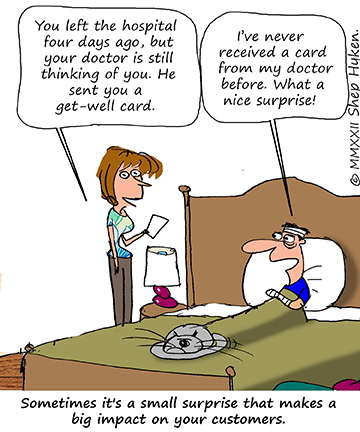 I love a surprise. Think about the last time you received a surprise from a friend or loved one. It doesn’t even have to be a big surprise. It could be something small – just something that proves the other person was thinking about you.
I love a surprise. Think about the last time you received a surprise from a friend or loved one. It doesn’t even have to be a big surprise. It could be something small – just something that proves the other person was thinking about you.
Has this ever happened to you in business? I receive surprise appreciation gifts from clients. I’m enjoying a box of chocolates a client sent as I create this post. And of course, I love surprising others. But what I want to share now is the example of a surprise that came from a most unlikely source, the TSA, as in Transportation Security Administration.
My friend and fellow professional speaker George Walther was returning from an event where he received an incredible award, Legend of the Speaking Profession. This is given to professional speakers who have contributed to the industry. As with many of these types of awards, they are represented in the form of a plaque.
The plaque was beautiful, and George was very careful to wrap it well as he placed it in his luggage. At the airport, George checked the suitcase and then after his flight went to the baggage carousel to retrieve it.
You may or may not know this, but checked luggage is X-rayed and sometimes even opened by TSA personnel doing random inspections to ensure the safety of the passengers. If you have experienced randomly searched luggage, then you’ll know that the TSA leaves a card stating “Notice of Baggage Inspection.” On this particular trip, George’s luggage was opened, inspected and the obligatory notice was placed on top of his clothes.
But there was something special about this particular notice.The TSA officer who inspected the contents of George’s suitcase noticed the reward and wrote, “Congratulations! IAD.” IAD, by the way, is the airport code for Dulles Airport in the Washington, D.C., area.
George not only smiled at the surprise message on the notice, but he also saved it. Years later he shared it with me. He was still talking about this surprise, which is why I was compelled to share his story.
Here’s the lesson. How much effort did it take to “surprise” George? Not much. It took literally seconds for the TSA employee to write one word followed by the initials of the airport. It showed that the employee was paying attention and looking for the opportunity to surprise a customer. I know, “customer” is an interesting way to describe a passenger who undergoes a random TSA search, but I think you get the point.
If a TSA employee inspecting luggage can surprise a passenger, it shouldn’t be hard for you to find ways to deliver small surprises to your customers.
Shep Hyken is a customer service expert, keynote speaker, and New York Times, bestselling business author. For information on The Customer Focus customer service training programs, go to www.thecustomerfocus.com. Follow on Twitter: @Hyken
customer service training programs, go to www.thecustomerfocus.com. Follow on Twitter: @Hyken
(Copyright © MMXXI, Shep Hyken)
The post A Small but Powerful Surprise appeared first on Shep Hyken.
January 18, 2022
Amazing Business Radio: Adrian Brady-Cesana
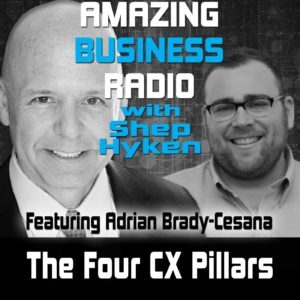 The Four CX Pillars
The Four CX PillarsInvesting in Customer Experience and Success Teams
Shep Hyken interviews Adrian Brady-Cesana, author of The Four CX Pillars to Grow Your Business Now: The Customer Experience Manager Playbook, and host of The CXChronicles Podcast. They discuss the four CX pillars: team, tools, process, and feedback.






 Top Takeaways:
Top Takeaways:Adrian Brady-Cesana shares what every customer experience manager needs to have in their playbook, the four CX pillars for business growth.
Team: Constantly train, evolve and optimize your CX team. Ask questions like: How are our CX team members hired? How are they trained? How are they retained? How does CX fit with the rest of the organization?Tools: The world has changed in terms of how we speak to our customers. It’s not always in person anymore. Oftentimes, it’s via phone, email, zoom calls, text message, etc. Each channel represents opportunities or challenges. Thinking about how you can pinpoint which tools will allow you to best serve your customer base is mission-critical for growth-focused companies.Process: Have a living playbook and a CX journey map. This could be as simple as a one-page document that gives everybody in the team clarity on what the expectations are. Your team should know where they can find consistent and up-to-date answers.Feedback: Collect, assess, and act on your customer & employee feedback to grow & scale your business. Take the time to share customer feedback with everyone in the organization – from the executives to the newest customer service rep. Some metrics may even lead to customer neglect. For example, a focus on Average Handle Time may lead to incomplete resolutions, striving for a larger customer support headcount may drain a company’s resources.Quotes:“If you want to see a big impact, you have to work on it regularly. If you want to have a world-class team, you have to invest in that team on a weekly basis.”
“Sharing customer feedback (what customers love, what customers aren’t so thrilled about, and what customers don’t like at all) in a clean, clear-cut way across the entire business is how any type of corporate culture can improve overnight.”
“CX is a team sport. If you are the only person in your organization who cares about CX, it’s just not going to happen.”
“CX is modern selling. Companies that understand that they should invest in incredible customer experience – and that every player on your team has a role – will dominate and last for a long time.”
About:Adrian Brady-Cesana has been working in customer experience, customer success, consulting with organizations for the past 15+ years. He is the author of The Four CX Pillars to Grow Your Business Now: The Customer Experience Manager Playbook, and host of The CXChronicles Podcast.
Shep Hyken is a customer service and experience expert, New York Times bestselling author, award-winning keynote speaker, and your host of Amazing Business Radio.
This episode of Amazing Business Radio with Shep Hyken answers the following questions … and more:
What are the 4 pillars of customer experience?Why should you invest in customer experience?What is a customer-focused business?What is the CX journey?Where does CX fit in an organization?The post Amazing Business Radio: Adrian Brady-Cesana appeared first on Shep Hyken.
January 17, 2022
5 Top Customer Service Articles of the Week 1-17-2022
Each week I read many customer service and customer experience articles from various resources. Here are my top five picks from last week. I have added my comment about each article and would like to hear what you think too.
7 Customer Service Skills Every Business Needs by Renee Johnson(The Tech Report) Much of the customer mindset will remain a mystery. There will always be things we don’t know about how consumers think. However, researchers have been collecting data on customer service satisfaction for years.
My Comment: We start this week’s Top Five with a list of seven customer service skills that EVERY business needs. As I read through the list, I couldn’t disagree. Some may be more relevant than others, and of course, we could have added quite a bit to the list, but this is a good start. If you sat down with your team and discussed these, I’m sure you’d come up with some ideas, as well.
6 Ways To Create a Consistent Customer Experience by John R. DiJulius III(Franchising.com) Does the level of experience your customers receive depend on which employee they encounter? Are there certain employees on your team you hope your best clients will interact with? If so, then you have what is known as employee roulette. Employee roulette is a problem most organizations have.
My Comment: And here is another list. This time it’s from my friend and fellow customer service expert, John DiJulius. John shares six important ways to create a company focused on customer service. He’s worked with some of the biggest brands in the world. You need to read this article now!
7 Effective Ways to Improve Your Customer Experience Strategy by Vineet Gupta(Business 2 Community) Customer experience or CX is a significant driver of your company’s success. Your business relies most on client patronage. So, it is dependent on how they feel every time they interact with your brand.
My Comment: Okay… One more list. I’m not familiar with the author, but I did enjoy his take on how CX is a “significant driver of your company’s success.” It starts with a definition of CX and then shares seven ways to improve it, including customer journey mapping, getting feedback from employees, personalizing the experience, and more.
Understand and Predict Customer Needs With Customer Journey Analytics by Simon Fraser(Retail Customer Experience) Customer journeys can change on a dime and the only guarantee is that today’s journey looks nothing like yesterday’s and tomorrow’s will certainly be something new.
My Comment: If you want to create a strong customer experience, you must understand your customers – enough to know what they want, even before they know themselves. This article touches on serval areas about your customer’s journey you want to explore to create an experience that meets and exceeds customers’ expectations.
What all Retailers Should Know About Outsourcing Customer Service by Darnell Witt(Retail TouchPoints) As your business grows, so too will the customer support tickets, making it critically important that you scale your support team alongside your customer or order growth. Why?
My Comment: Ever thought of outsourcing your customer’s service department. Some of the biggest and best brands do – and some smaller companies, too. While the article is short, if you’re thinking of hiring an outside company to help deliver an amazing customer service experience, this article will give you some thoughtful ideas worth considering.
BONUS62 of the Best Quotes About Customer Experience by Steven Van Belleghem(Steven Van Belleghem) Always looking for original and creative insights about customer experience for my content channels, books, and keynotes, I often come across motivating quotes from peers about how to better treat customers. Today, I wanted to offer you some inspiration with my top favorite quotes in the matter.
My Comment: Here is a list of 62 customer service quotes compiled by my friend Steven Van Belleghem. I’m honored to be included in the list. There are plenty of great quotes you’ll be able to use as conversation starters and to infuse a little customer service motivation into your team meetings.
[image error]Shep Hyken is a customer service expert, professional speaker, and New York Times bestselling business author. Go to The Customer Focus to learn more about our customer service training programs. Follow on Twitter: @Hyken
to learn more about our customer service training programs. Follow on Twitter: @Hyken
The post 5 Top Customer Service Articles of the Week 1-17-2022 appeared first on Shep Hyken.
January 14, 2022
Guest Post: Why Do So Many Companies Struggle to Connect with Customers?
This week we feature an article by Todd Zerbe Senior Vice President of Engineering at Avaya. He shares why a neutral experience is just as bad as a negative experience and what can turn a neutral customer experience into an amazing one.
Think about your most recent customer experience. Chances are everything was fine but is “fine” good enough? For competing organizations, a “fine” or neutral experience is just as bad as a bad experience because they’re not gaining any traction.
Research shows the average dissatisfied customer will tell 12 people about a bad service experience. If the experience is positive, the customer may tell a few friends or family members or write a review. If it’s neutral, however, they will usually tell no one. That’s because there’s no sense of actually enjoying the engagement experience. There’s no authentic connection.
Without this connection, customers will find themselves caught in a web of faceless companies providing just “okay” experiences. For most of these organizations, a toll-free number or a dedicated email address is as far as customer support gets. Even if they have graduated to more enhanced capabilities like a 24×7 chatbot, there’s usually a lack of personalization. It’s this personalization that turns a neutral customer experience into an amazing one. In fact, without it, the technology you implement will work against you.
Start with the Experience, then Implement Relevant TechnologyAgain, think about your own experiences as a consumer. If you take the time to complete a post-call survey with your bank and note that you like speaking directly with a person versus an automated system and your bank continues to make you jump through IVR hoops, will that lead to satisfaction or frustration? Will you feel heard as a customer, or neglected? Customers aren’t asking much from the brands they do business with; they just want to be understood.
This is where companies must start to create authentic customer connections. Successful organizations start with the experience – what customers expect from their company – and then leverage technology to deliver that at scale. This makes a Voice of the Customer (VoC) program crucial. To gain a better understanding of your CX needs, you must capture your customers’ expectations, preferences, and aversions through customer listening and insights. This can be achieved in a few ways including post-call surveys, social listening, assessing NPS scores, feedback management, and reputation management. Gaining this understanding will also help you better align your various lines of business (marketing, sales, service, and product teams).
Combined with data from your CRM and these VoC techniques should provide you with a relatively clear view of what customers want from your brand based on a volume of collected data. This should include customer, historical, and transactional data such as interaction history, campaign history, customer verification, and upselling and cross-selling. From this vantage point, you can then start thinking about how technology will help your organization advance a positive customer experience.
Examples of Authentic, Data-led Customer ConnectionsFinancial services is cited as one of today’s least trusted industries, and there’s a reason for that. If you fill out an online form, your personal information is sent to what feels like every financial institution in the country. You’ll find yourself dodging (and even blocking) phone calls and getting inundated by snail mail with generic “special” offers – all designed to sell, not help. If you’re a bank doing an outbound campaign, that makes it extremely difficult to get in touch with one of your customers – let alone authentically connect with them. Imagine being able to call a customer with an automated personalized greeting (“Hi XXX, this is your personal banker trying to connect with you. Do you have a few minutes to talk about XXX?”). Or, maybe you offer to digitally redirect the customer to a mobile or web self-service experience based on their data profile. Imagine the impact of this automation with a personal touch. Sticking with banking, more research has been coming out lately showing the role that regional accents play in customer service and brand relationships. Using available data, you may see that a customer’s first language is Spanish; therefore, you connect them with a Spanish-speaking agent for better engagement. While simple, it’s these kinds of efforts that go a long way in the customer-brand relationship. There are also simple applications of AI that can detect a customer’s sentiment and tone so that if they are feeling uncomfortable, the interaction can be appropriately resolved. For example, if they are uncomfortable engaging with a machine, they can be automatically escalated to a live agent to help further.Customer experience should not be measured by the fact that “everything was fine.” Fine is nothing out of the expected ordinary. To rise above the competition, companies need to create extraordinary experiences that connect with customers – building trust, loyalty, and lifelong relationships.
Todd Zerbe is Senior Vice President of Engineering at Avaya. He brings more than twenty-five years of software development experience to Avaya. Todd leads the company’s engineering functions, teams and programs globally, helping Avaya to innovate the best platform and applications meeting the needs of customers across multiple vertical markets and geographies.
 For more articles from Shep Hyken and his guest contributors go to customerserviceblog.com.
For more articles from Shep Hyken and his guest contributors go to customerserviceblog.com.
Read Shep’s latest Forbes article: President Biden Signs Executive Order To Improve Customer Service “For The People”
The post Guest Post: Why Do So Many Companies Struggle to Connect with Customers? appeared first on Shep Hyken.
January 12, 2022
The Omnichannel Experience – What the Heck Does That Mean?
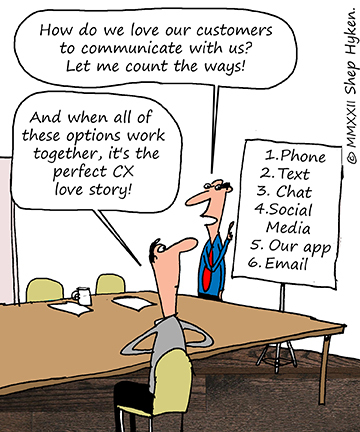 There is a term in the customer service world that is often misused or misunderstood. That term is omnichannel. I have had many conversations with clients about the omnichannel experience, and I’ve even shared content about it with our subscribers in the Shepard Letter and my videos. It’s time to bring it back with what may be the perfect example.
There is a term in the customer service world that is often misused or misunderstood. That term is omnichannel. I have had many conversations with clients about the omnichannel experience, and I’ve even shared content about it with our subscribers in the Shepard Letter and my videos. It’s time to bring it back with what may be the perfect example.
First, let’s talk about the basic definition. It all started with a concept known as multi-channel. This was about different ways customers could communicate with you. For example, they could use phone or email. That’s two channels. Today there are many others, such as text, social media, apps, and more. It doesn’t matter how many channels you have, once you get past one, you are in the world of multi-channel. The problem is that while multi-channel gives you options to choose your favorite method of communication if you switch from one channel to the next, you typically have to start the conversation over.
Then the phrase omnichannel came around. This meant that you could cross from one channel to the next and have seamless conversations. That’s where people get confused. What does that really mean? Well, here’s my “perfect” example to describe the omnichannel experience, which by the way, is what you want to provide for your customers.
I bought my wife one of those high-end electronic massagers to use whenever her muscles are tight after a tough workout. I was so excited to give it to her. As she unwrapped it, she was excited as well. That was until we plugged it in. When we did, nothing happened.
Maybe the battery wasn’t charged, so I connected the charger and let it sit for a few hours. We came back and turned it on, and again, nothing happened.
I immediately went to the company’s website, opened the FAQ (Frequently Asked Questions) page, but didn’t find my answer. A pop-up window asked if I needed help, so I started to interact via chat. It could have been an AI-infused chatbot or a human typing back. It didn’t matter. The result was a request to send a video of the problem or have a video chat, like Facetime, with them so they could see if I was properly charging and turning on the unit. So, I shot a quick video of me connecting the charger and showing them that the on/off light wasn’t coming on. I sent it to them and within a few minutes, I received an email that confirmed there was definitely something wrong with my unit and they would send a new one. Just two hours later, I received an email notifying me that a new massager was on its way. Two days later it arrived.
In that scenario, I used the website FAQ, live chat, video, and email. The conversation crossed seamlessly and flawlessly from one channel of communication to the next. A perfectly executed omnichannel experience.
So, now does omnichannel make sense?
Shep Hyken is a customer service expert, keynote speaker, and New York Times, bestselling business author. For information on The Customer Focus customer service training programs, go to www.thecustomerfocus.com. Follow on Twitter: @Hyken
customer service training programs, go to www.thecustomerfocus.com. Follow on Twitter: @Hyken
(Copyright © MMXXI, Shep Hyken)
The post The Omnichannel Experience – What the Heck Does That Mean? appeared first on Shep Hyken.
January 11, 2022
Amazing Business Radio: Eng Tan
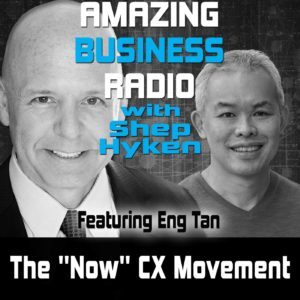 The “Now” CX Movement
The “Now” CX MovementChanges Customer Experience Teams Need to Make to Meet the Demands of the “Now” Customer
Shep Hyken interviews Eng Tan, author of Experience is Everything and CEO of Simplr, a company that is redefining the way brands deliver CX. They discuss what CX teams need to let go of in order to succeed in the new era of CX.






 Top Takeaways:
Top Takeaways:The old perceived notions of control and measures of customer success are misused or no longer relevant in the new era of CX.
Some metrics may even lead to customer neglect. For example, a focus on Average Handle Time may lead to incomplete resolutions, striving for a larger customer support headcount may drain a company’s resources.
In order to meet the demands of the always-on, demanding, “NOW” customers, Eng Tan recommends that CX teams make the following changes or risk getting left behind by their competitors:
“Let go” of old CX metrics – Let go of some of the old customer service metrics that are not doing anything for your business. When specific metrics, such as NPS or AHT, are used in isolation, they don’t tell the full story.“Let go” of the omnichannel arms race – Brands tend to stretch themselves too thin across multiple modalities and increase the effort level for customers. But, at the end of the day, customers will choose ease of resolution over channel choice. Train your customers on the best way to get support.“Let go” of old ways of measuring internal influence. – We often hear this question in the customer service world: How many agents do you have? CX leaders should stop measuring their influence by their headcount and instead focus on insights provision, brand, loyalty and revenue impact, and operational resiliency.In this episode, Eng Tan also talks about his new book Experience is Everything, customer neglect, and organizational changes that CX teams need to make to stay competitive in the market. Tune in!
Quotes:“When specific metrics, such as NPS or AHT, are used in isolation, they don’t tell the full story.”
“Conversion rates, repeat purchase rates, and customer lifetime value are influenced not only by the quality of products and services but by how well customer service executes.”
“Customers will choose ease of resolution over channel choice. Train your customers on the best way to get support.”
“The always-on, demanding, “NOW” customers are not going away. CX teams need to start making their operating model changes today or risk getting left behind by the market.”
“Customer neglect is a bigger problem than what most leaders realize.”
About:Eng Tan is CEO of Simplr, a company that is redefining the way brands deliver CX. He is the author of Experience Is Everything: Winning Customers’ Hearts, Minds, and Wallets in the Era of NOW CX.
Shep Hyken is a customer service and experience expert, New York Times bestselling author, award-winning keynote speaker, and your host of Amazing Business Radio.
This episode of Amazing Business Radio with Shep Hyken answers the following questions … and more:
What us a NOW customer?Are customer service metrics still relevant?What is customer neglect?Is an omnichannel approach good for customer experience?How should CX leaders measure their team’s impact?The post Amazing Business Radio: Eng Tan appeared first on Shep Hyken.



